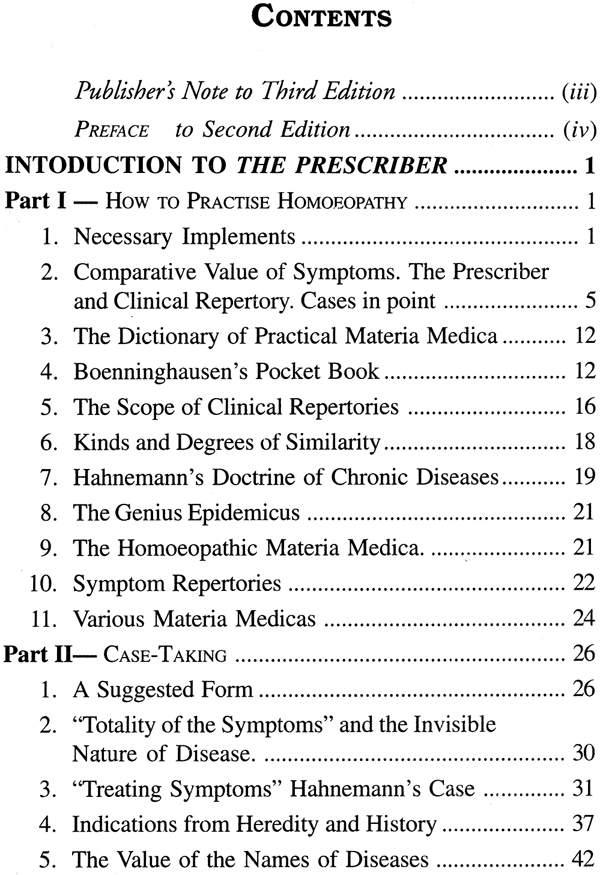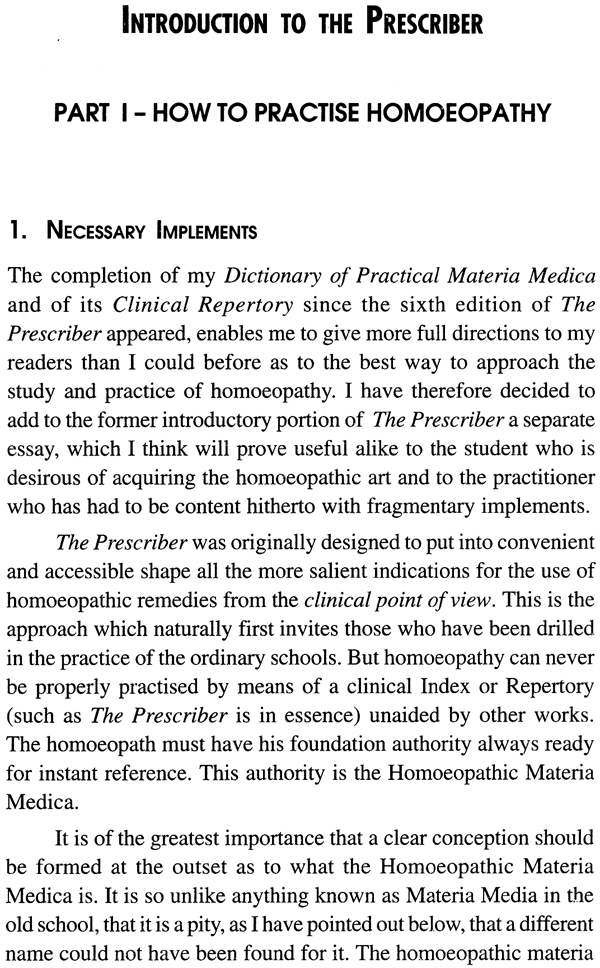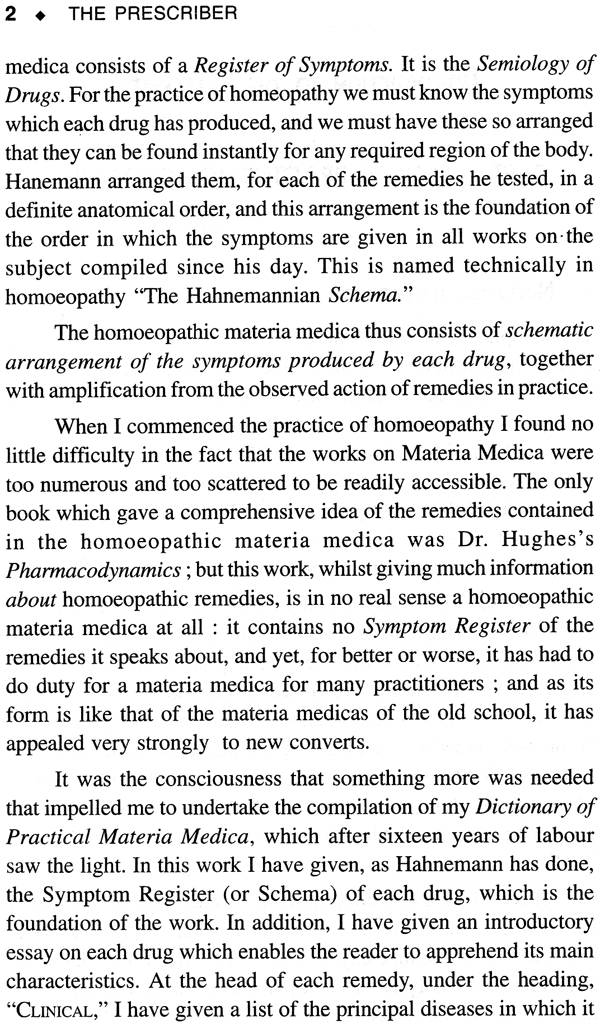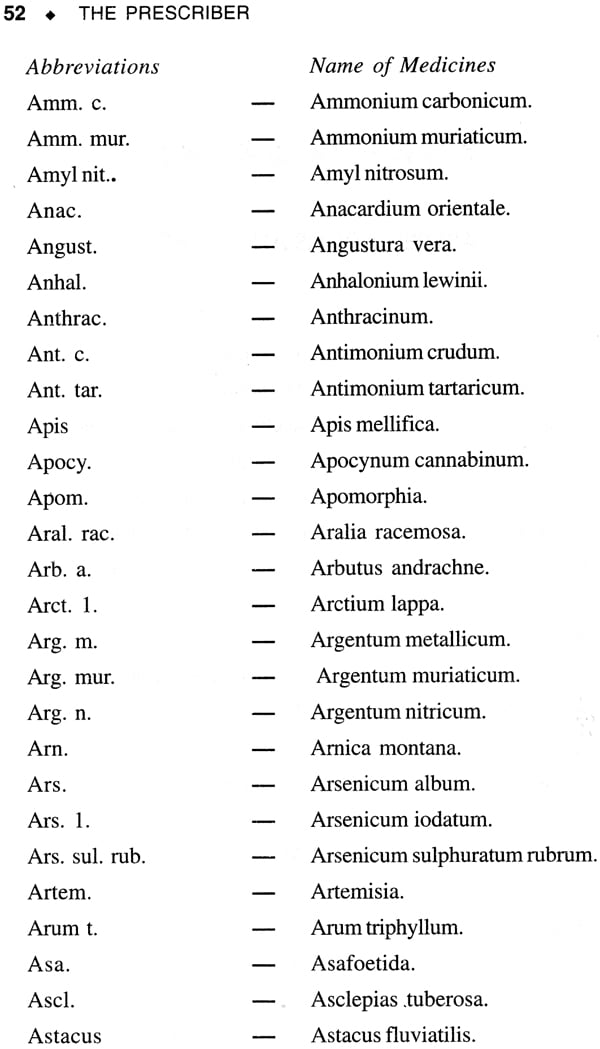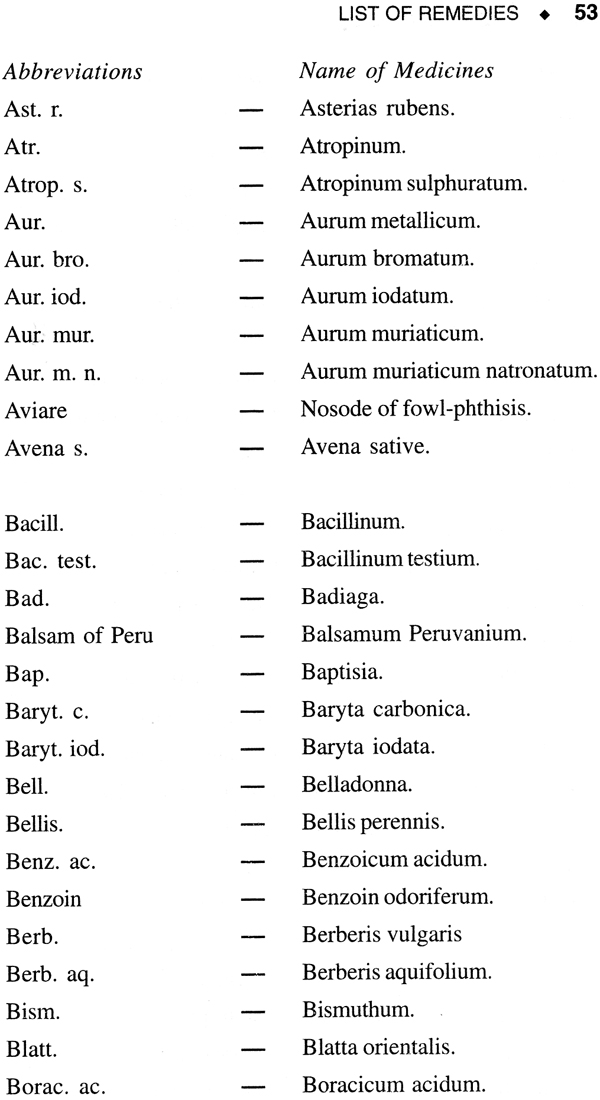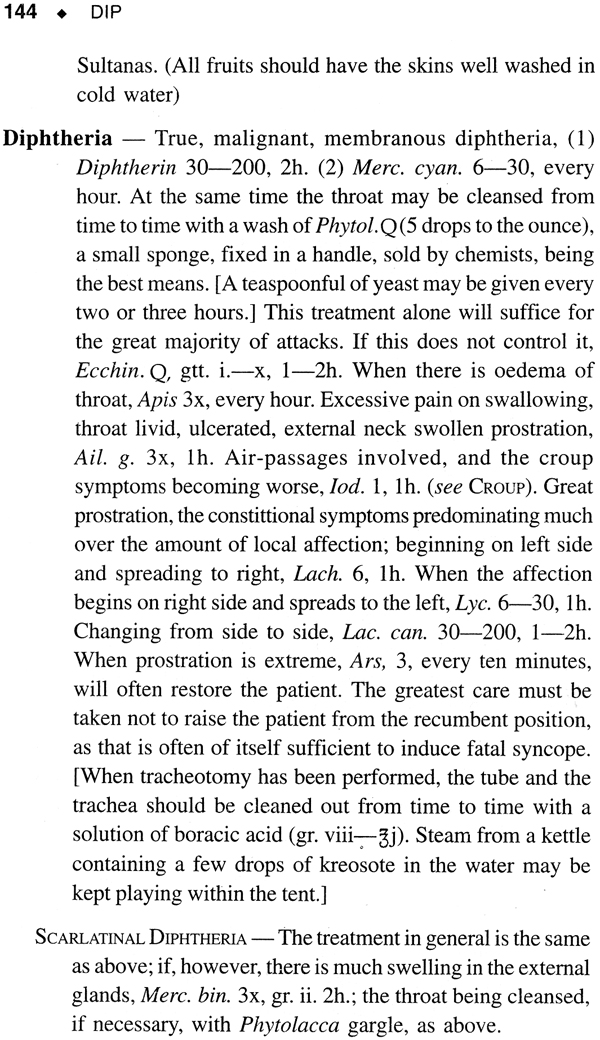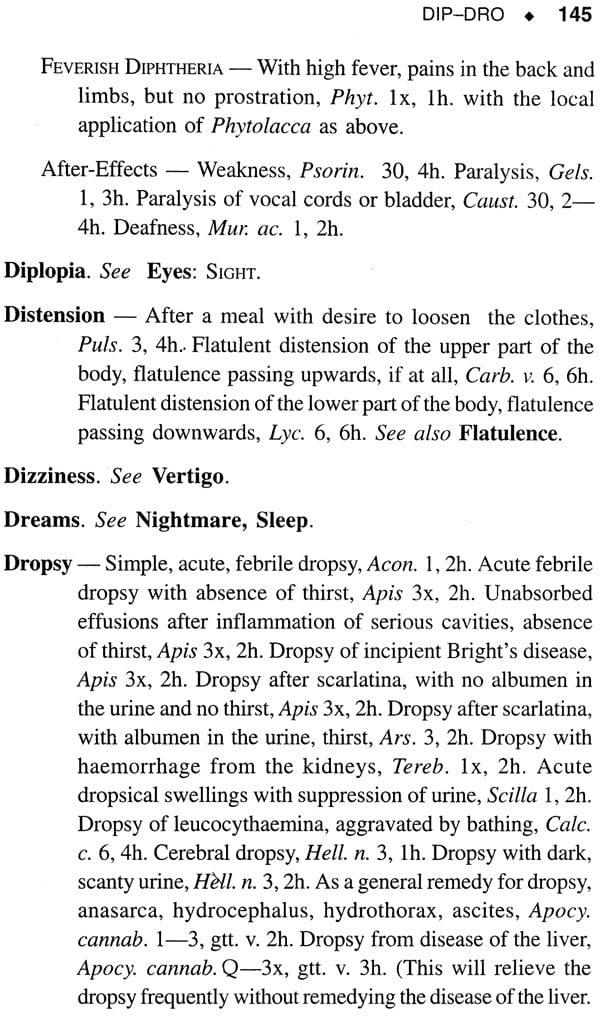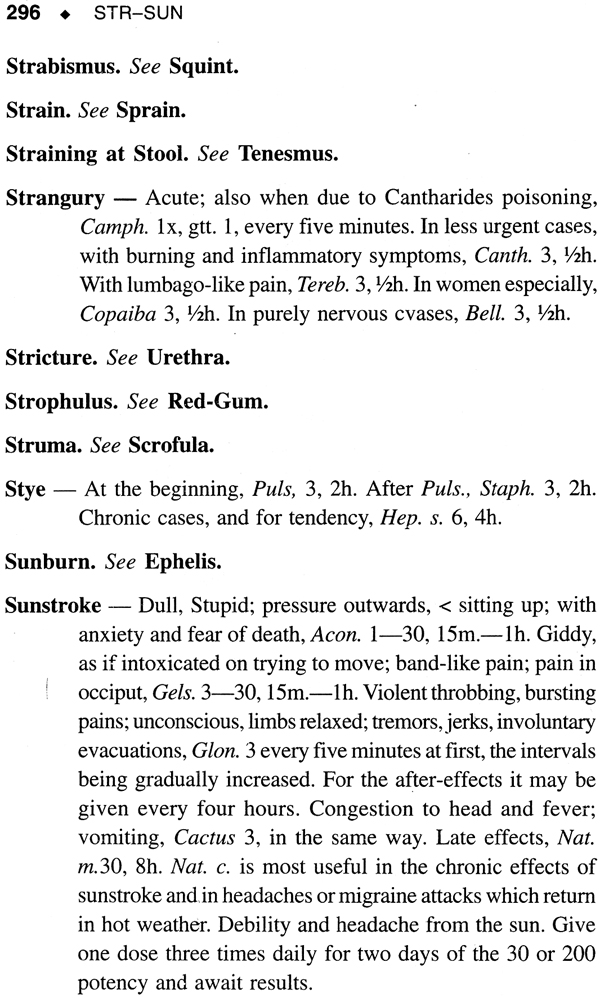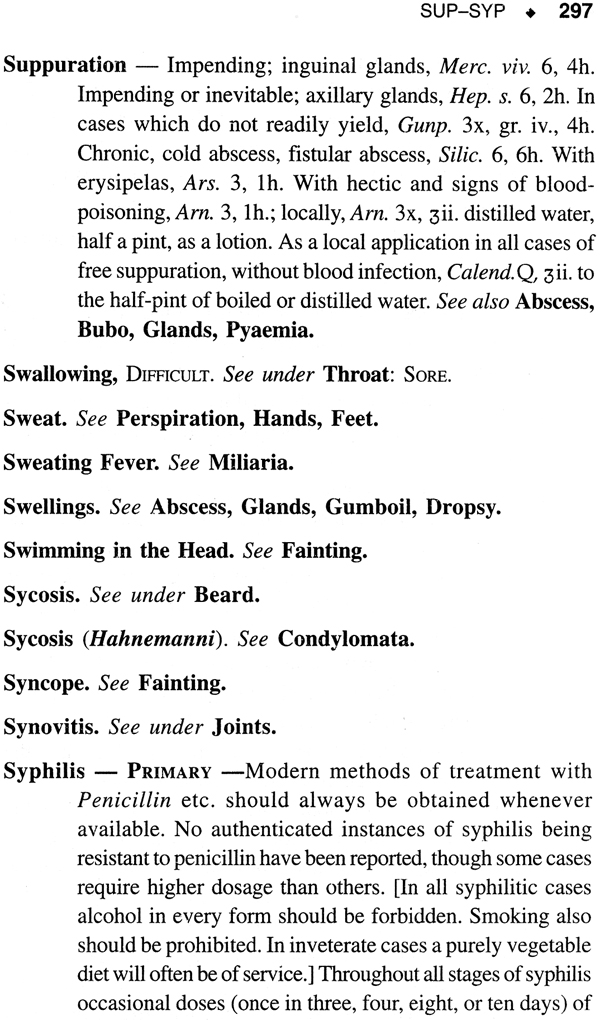
The Prescriber
Book Specification
| Item Code: | NAS397 |
| Author: | J. H. Clarke |
| Publisher: | B. Jain Publishers (P) Ltd |
| Language: | English |
| Edition: | 2017 |
| ISBN: | 9788131902899 |
| Pages: | 356 |
| Cover: | PAPERBACK |
| Other Details | 8.50 X 5.50 inch |
| Weight | 330 gm |
Book Description
The Prescriber, by John Henry Clarke, was first published in 1885 (updated in 1925) and it still finds utility over a century after its debut. With an essay on "How to Practice Homoeopathy", this little book has helped thousands of lay practitioners to prescribe successfully. and carry the message of homoeopathy worldwide. In this work the names of diseases are given in alphabetical order like a dictionary and under each such heading, the name of medicine or medicines most useful in the particular disease are given. When more than one medicines are named, they will be found prefixed to each symptom which would help the prescriber to choose that in preference to the rest. When no such differentiating symptoms can be given, the ° medicines are named & numbered in order of their general applicability. This work is one of the classical works written for homoeopathic therapeutics & which is enriched with Clarke experience of several years of practice & study.
Dr. Clarke (1853 - 1931) was one of the most eminent, homoeopaths of England. He practiced at Bolton Street, Piccadilly, located in London. He was a consulting physician to the London Homoeopathic Hospital. He was the editor of the 'Homoeopathic World’ for twenty-nine years. He was a prodigious worker as his published works testify. His priceless contributions include : The Dictionary of Practical Materia Medica, A Clinical Repertory to the Dictionary of Materia Medica, Dictionary of the Domestic Medicine, Gun Powder as War Remedy, Homoeopathy Explained and many more.
The Prescriber was first published by the firm of Messrs. Keene & Ashwell. Mr. Ashwell was himself the author of the invaluable Companion to the British and American Homoeopathic Pharmacopeias, a volume of about the same size as THE PRESCRIBER. It may interest readers to know how I came to compile the book. I had been at the time some nine years in homoeopathic practice, and the only work of reference of the kind put into my hands by my instructors was the Clinical Index of Dr. Ruddock’s well-known Vade Mecum. Excellent as this 1s, it is of necessity limited, and although I had my copy interleaved this soon became overloaded, and so I set about compiling a work which should more or less completely cover the whole ground. In this instance, as in that of most of my other works, my own necessities led to its compilation. J needed it for my own use, so that I might find instantly, without reference to long treatises or dissertations, the points needed for present application in the cure of the sick.
The prompt acceptance of the work by the homoeopathic profession proved that I had not been wrong in believing that others had felt the need of a work of the kind as well as myself. And there has been no slackening in the demand for it ever since. A large edition has appeared in America, and it has been translated into Spanish for the benefit of the great Spanish-speaking population of both hemispheres.
The exhaustion of the last English edition has given me an opportunity of putting it through a complete revision, and very few are the pages on which I have not seen cause to make some addition. For the sake of Indian readers and those Britons whose lives are spent largely in tropical countries I have added items on diseases which are mostly met with in those parts. In compiling these the admirable work by Drs. E. A. Neatby and T. Miller Neatby, A Manual of Tropical Disease and Hygiene for Missionaries, has been of great assistance. Another acknowledgement I have to make is to my friend Mr. W.H. Knight, the literary executor of the late Dr. Leopold Salzer of Calcutta, who, when he heard there was to be a new edition of THE PRESCRIBER, sent me his own annotated copy. In this he has collated therapeutic items from many sources, including my own Materia Medica. A large number of these will be found fitted into their own appropriate niches in the present edition.
The position of THE PRESCRIBER in medical literature is unique. There are books in abundance which tell all there is to tell about diseases, their history, etiology, course, progress, pathology, histology and all the rest. But the weak point of them all is when they come to tell of the treatment. The directions these works give for treatment are couched in generalities as a rule. THE PRESCRIBER deals with nothing else but treatment, and the directions, instead of dealing with generalities, go into minute particulars for ready application to any case of any disease. The descriptions of disease I leave to its describers, and thank them for doing that part of the work. my part is to tell the practitioner what he can do when he has learned all the others can teach him.
That there are many in old school ranks who are anxious to learn I have good reason to know. The Lancet has quite recently acknowledged that the homoeopathic doctrine is true; but after delivering itself of the admission it stops there, and does not proceed to take the action which the admission would seem to require. It says "if the proof of the pudding is in the eating," it is impossible to deny that likes cure likes. But it declines to eat of the pudding or to invite its readers to the feast. So the task of providing the banquet is still left to the homoeopathic body, and as long as healers of the sick can find in THE PRESCRIBER the nourishment they require, it shall be served up for them as well and as daintily as its author and publishers can effect.
Before concluding this preface I wish to say a word to my readers on behalf of that most important and essential person the homoeopathic chemist. It is impossible for anyone to practise homoeopathy properly without the aid of a skilful and conscientious chemist. No medical man can collect, prepare and dispense all the remedies of the homoeopathic pharmacopeia by himself. He must have a pharmacist to do this for him, if not in the same locality as himself, yet somewhere within the reach of the post, even if it is a thousand miles away. It is nothing short of a calamity to homoeopathy that of late years many homoeopathic pharmacies have had to close down. The spread of "stores" has had a good deal to say to that, but not all. If homoeopathic doctors had made more use of homoeopathic chemists and done less dispensing themselves it would have been better for both. As for homoeopathic medicines dispensed at "stores," I take no responsibility for them. They may be quite genuine and of proper dilutions, but at best they are second- hand. The "stores" do not keep skilled homoeopathic chemists who know all about the characters of the drugs used by homoeopaths, and that is what the homoeopathic practitioner needs. When the right chemist is found, let him have all his share of the work. In localities where there is no chemist the practitioner must perforce be his own dispenser.
Trusting I may be pardoned for this lengthy preface to THE PRESCRIER’S new edition on its fortieth birthday, I herewith make my bow to my readers and hope they will find in it all they expect.
**Contents and Sample Pages**
